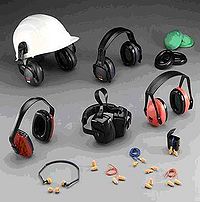Hearing Protectors
The surest method of preventing occupational deafness is to reduce noise at the source by engineering methods. However, in certain workplace conditions, there is very little or nothing one can do to reduce noise at the source. In such workplaces, workers wear hearing protectors to reduce the amount of noise reaching the ears.
People should wear a hearing protector if the noise or sound level at the workplace exceeds 85 decibels (A-weighted) or dB(A). Hearing protectors reduce the noise exposure level and the risk of hearing loss.
If hearing protection is required, then a complete hearing conservation program should be instituted. A hearing conservation program includes noise assessment, hearing protector selection, employee training and education, audiometric testing, maintenance, inspection, record keeping, and program evaluation.
The effectiveness of hearing protection is reduced greatly if the hearing protectors do not fit properly or if they are worn only part time during periods of noise exposure. To maintain their effectiveness, they should not be modified. Remember, radio headsets are not substitutes for hearing protectors and should not be worn where hearing protectors are required to protect against exposure to noise.
Selection of hearing protection
- Correct for the job. Refer to the Canadian Standards Association (CSA) Standard Z94.2-02 (Reaffirmed 2011) "Hearing Protection Devices - Performance, Selection, Care and Use" or contact the agency responsible for occupational health and safety legislation in your jurisdiction for more information.
- Provides adequate protection. Check the manufacturer's literature.
- Comfortable enough to be accepted and worn.
Types of hearing protectors
- Ear plugs are inserted to block the ear canal. They may be premolded (preformed) or moldable (foam ear plugs). Ear plugs are sold as disposable products or reusable plugs. Custom molded ear plugs are also available.
- Semi-insert ear plugs which consist of two ear plugs held over the ends of the ear canal by a rigid headband.
- Ear muffs consist of sound-attenuating material and soft ear cushions that fit around the ear and hard outer cups. They are held together by a head band.
